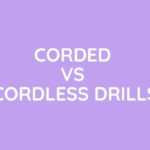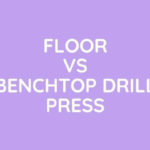So after completed your tiling work in your shop, home building, or anywhere and it’s all looking wonderful and beautiful. But your all hard work could go in the vein by drilling tiles for your other use like for now installing bathroom accessories, shelves, and many more other required in fittings. But not to worry as we will let you know every information providing you step by step on how to drill into tiles without cracking in the process.
Before even thinking about drilling through your newly installed tiles, you should make sure and know the facts about what you are dealing with and should know precisely what you are going to drill because once you spoil it, there is no going back to perfect beautiful tiles.
Porcelain and natural stone tiles are preferred by many more people nowadays, and they are a lot tougher than ceramic tiles to drill, meaning that you’ll have to exert a little more effort to break on through to the other side. You need to require all equipment and tools to perform your drill that is designed in a way so that they can easily penetrate through the tiles without harming or breaking of ties.
Contents
How To Drill Into Tile- Step By Step Guide
Step 1: Measurement And Mark
If you have a few holes to drill, you should consider creating an arrangement with a small piece of a block of wood. Drill a hole through the wood that’s the same as the diameter of the drill bit you’ll be using and place this over the area on the tile using the hole as a mark for the drill by holding it in place with your hand.
Drill guides can also be used to increase precision when drilling through tiles. Company’s nowadays manufacturers these products and manufactures plastic casing that is attached to the tile and then drilled through. Other types include a steel plate with guide holes that are committed to the surface to be functioned at drilled with a pressure cup, allowing both horizontal and vertical holes of precise diameters to be drilled up to mark.
This type of accessory might be a little expensive. But they are more reliable and can be used over again and again over time, so they are a good investment if you are a regular user.
Step 2: Start To Drill
Breaking through the glaze tiles is not an easy job. The drill bit and creates vibrations and heat that can easily crack and ruin the tile. Take the initiate slow and start on low speed, apply pressure evenly with light hands until you have jaded through the top layer of glaze. Once you’ve penetrated the first layer, you can then chronically increase your speed and pressure as required (not too much) to drill through the tile to the wall.
Once you get through the tile and hit the surface of the wall, keep the drill slow and steady tight up against your grip so that it does not blow apart.
Step 3: Keep Your Bits Cool
Alternatively, you can also hold a wet sponge along the drill bit. It will not only help you in cooling the drill bit from overheating but will also absorb dust and debris from the drilling. However, be extremely careful not to expose the motorized section of the drill to water as it can lead to a short circuit of tool you even can get shocked after the circuit breaker.
Some of the devices in use lately has helped this heating problem like a multi drill spray system. This type of device comes really in use if you are a regular base operator, or you are working continuously for an extended period. Using carbide tipped drill bits, they will stop as they found out they are too hot and need to be kept cool while using it.
Diamond tipped bits will continue to work even when they are heated, which can lead to real consequences, as long as you allow them to cool down periodically. Keep in mind for prolonged use of the drill, always keep your drill cool and don’t apply too much of force pressure during the drill.
Step 4: Change Your Drill Bit According To The Surface
It’s highly improbable that tiles will have been installed atop of metal or alloys, but there could be some metal struts or supports behind the substrate. If you need to drill into them, then standard high-speed steel (HSS) drill bit should be used. For more vital metals that are harder to drill, such as stainless steel or cast iron, it’s advisable to opt for a black oxide or cobalt steel drill bit.
Protective Tools
Before starting any of your processes, one should know all the protective measures and must have all the protective tools along as drilling involves high power drilling tools, the spare particle leach. At the same time, drilling can also harm you in many ways, so there are some of the protective tools you should use while drilling. Another essential part of drilling into tiles without any crack and smoothly, we should have all the required tools to perform, so here are some of them.
Things You Would Need To Drill Into Tiles
Protective Kit
- Safety goggles.
- Dust mask.
- Latex grip safety gloves.
Tools
- Masonry drill bit
- Wood drill bit
- Diamond tripped drill bit
- Drill.
- Wooden block
- Tape measure
- Wet sponge
- Masking tape
A power drill is the priority and required when carrying out the drilling process, but the most critical component in successful drilling through any the tile is the drill bit itself; there are many different types of bit in the market available, and each bit has its different specialty and used for an other task. You should never use an old or rusted drill bit as it loses its sharpness and power as rust accumulates on the surface they’re not as efficient and precise as brand-new ones. If you use an old one, it’s less likely to perform at the required capacity, and you’re more likely to damage the surface of the tile or could crack the tiles in the process.
As I have told you previously, drilling through tile requires a specialist and authentic drill bit regular bits won’t do the perfect drilling as they’re not strong enough to penetrate tiles without harming or cracking the surface. As an alternative, you should pick for either carbide-tipped bit or diamond-tipped drill bits. The diamond-tipped drill is one of the costly tools, but it’s worth buying a product as its power will provide you a smooth and easy drill.
Carbide-tipped masonry drill bits are the more common of the other two and readily available in almost all hardware shops, or you can also purchase them through online sites like amazon. They’ll do a perfectly serviceable job of drilling ceramic and all manner of glazed tiles, but they are not advised for use with porcelain stoneware. Harder materials such as porcelain, vitrified porcelain, and quarry tiles require not only a bit more elbow grease as they are tough surfaces to drill on you will need to have a diamond-tipped drill bit too.
Top Three Drill Products
1. DeWalt DCD701F2 12-Volt Drill
- DCD701 12V MAX Brushless 3/8-in drill/driver has 32% more power (when using DCB122 2.0Ah battery vs DCD710 drill/driver...
- DCD701 12V MAX* Brushless 3/8 in.Drill Driver is 20% shorter**
- Brushless motor for efficient performance and runtime
The DeWalt DCD701F2 12-volt drill it’s the best combination of power, comfort, and convenience in a way that none of the other drills can comfort user. It can bore 30 1-inch holes through a 2-by-10 on a single battery charge, which makes this tool great for a long time run-saving much of a time of the user.
2. Bosch PS31-2A 12V Max 3/8 In. Drill/Driver Kit
- PREMIUM PERFORMANCE-TO-SIZE RATIO: Professional grade power at a light-weight of 1.8 Lbs.; The performance-to-weight...
- VERSATILE USE: The high torque and the convenience of two speed settings allows the Bosch PS31 2A power drill to tackle...
- PRECISION: This electric drill driver combo has two speeds (0-350 RPM and 0-1,300 RPM) and 20 plus 1 clutch settings,...
This 12-volt Bosch could not drill as many 1-inch holes as the DeWalt. But it still has more than enough power required to perform a certain amount of work for general home tasks or small projects. It is 5 ounces lighter than the DeWalt 12-volt, but it feels more massive to most of the users as the weight distribution of the product is not that good.
3. Dewalt DCD791D2 20V Max XR Li-Ion Brushless Compact Drill
- DEWALT drill with brushless motor delivers up to 57% more run time over brushed.
- XR Li-Ion batteries with fuel gauge provide this power drill 33% more capacity over standard packs
- DEWALT 20V MAX drill is compact (6.9 inch front to back), lightweight (3.4 lbs) design fits into tight areas.
This is a large 20-volt drill, but it shares all of the significant required essential characteristics of the smaller tools; also, 12-volt DeWalt it’s potent and extremely comfortable to hold and use because of the grip they provide and the comforting little features, such as the belt hook and the case. Compared with our 12-volt pick, this more massive drill completes more challenging jobs much faster, saving our valuable time, doing the same work in less than half the time; with a long-lasting battery, it’s like the cherry on the cake. Make sure whatever you choose is accurately powered.
FAQs
1. What is the best drill bit for ceramic tile?
Bits with ground tungsten carbide or diamond tips are one of the first choices of the user; it is the best for purpose. You can also use another bit, but it can ruin your tiles along.
2. How, can I tell if my tile is ceramic or porcelain?
Ceramic tile has a glassy surface giving it its color and smooth finish. Porcelain tiles may be glassy looks attractive but are frequently not.
3. Do I need a hammer drill for tile?
Never uses a hammer for ceramic tiles hammer will unevenly distribute for applied pressure and can cause damage to tiles.
Final Thoughts
If you follow all the above steps and advise in mind, then you can quickly successfully drill into the tiles in no time. There are a couple of essential things you must know and should be kept in mind before performing the process. You should carefully decide what you’re going to do. Drilling, boring, or reaming.
Make sure you have the right drill bits bit plays a significant role in drilling. Drilling through tiles need patience and calm. A person should be calm, and the most prominent quality you can have when performing your drill is patience. Don’t panic or rush as the bit can get vigorously heated, which can leads to the cracking of tiles.












Leave a Reply